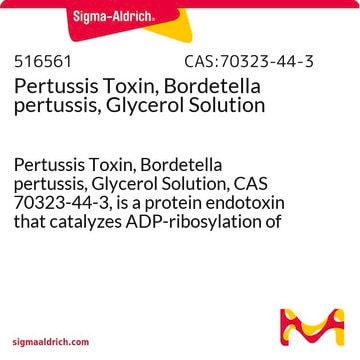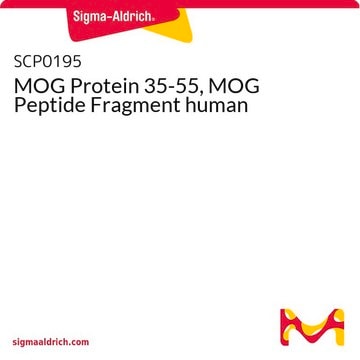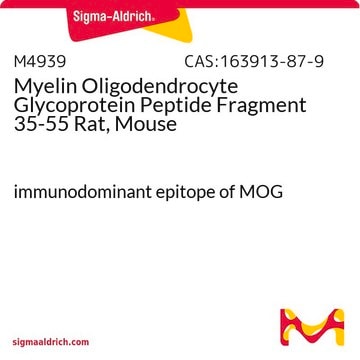516560
Pertussis toxin
from Bordetella pertussis, Five distinct bands by SDS-PAGE, lyophilized, protein endotoxin, Calbiochem
Sinónimos:
Pertussis Toxin, Bordetella pertussis
About This Item
Productos recomendados
product name
Pertussis Toxin, Bordetella pertussis, This Pertussis toxin, CAS 70323-44-3, catalyzes ADP-ribosylation of guanine nucleotide-binding regulatory proteins Gi, Go, and Gt.
Quality Level
form
lyophilized
manufacturer/tradename
Calbiochem®
storage condition
do not freeze
foreign activity
adenylate cyclase ≤35 pmol/min-μg (in the presence of calmodulin)
shipped in
ambient
storage temp.
2-8°C
¿Está buscando productos similares? Visita Guía de comparación de productos
General description
Application
Biochem/physiol Actions
Guanine nucleotide-binding regulatory proteins Gi, Go, and Gt
Warning
Physical form
Reconstitution
Analysis Note
Other Notes
Fryer, M.W. 1992. Neurosci. Lett.146, 84.
Gierschik, P. 1992. Curr. Topics Microbiol. Immunol.175, 69.
Harada, J., et al. 1992. Eur. J. Pharmacol.227, 301.
Hausman, S.Z., and Burns, D.L. 1992. J. Biol. Chem.267, 13735.
Kaslow, H.R., and Burns, D.L., 1992. FASEB J.6, 2684.
Zhu, J., et al. 1992. J. Pharmacol. Exp. Therap.263, 1479.
Hewlett, E.L., et al. 1983. Infect. Immun.40, 1198.
Moss, J., et al. 1983. J. Biol. Chem.258, 11879.
Legal Information
Storage Class
13 - Non Combustible Solids
wgk_germany
WGK 3
flash_point_f
Not applicable
flash_point_c
Not applicable
Certificados de análisis (COA)
Busque Certificados de análisis (COA) introduciendo el número de lote del producto. Los números de lote se encuentran en la etiqueta del producto después de las palabras «Lot» o «Batch»
¿Ya tiene este producto?
Encuentre la documentación para los productos que ha comprado recientemente en la Biblioteca de documentos.
Nuestro equipo de científicos tiene experiencia en todas las áreas de investigación: Ciencias de la vida, Ciencia de los materiales, Síntesis química, Cromatografía, Analítica y muchas otras.
Póngase en contacto con el Servicio técnico







